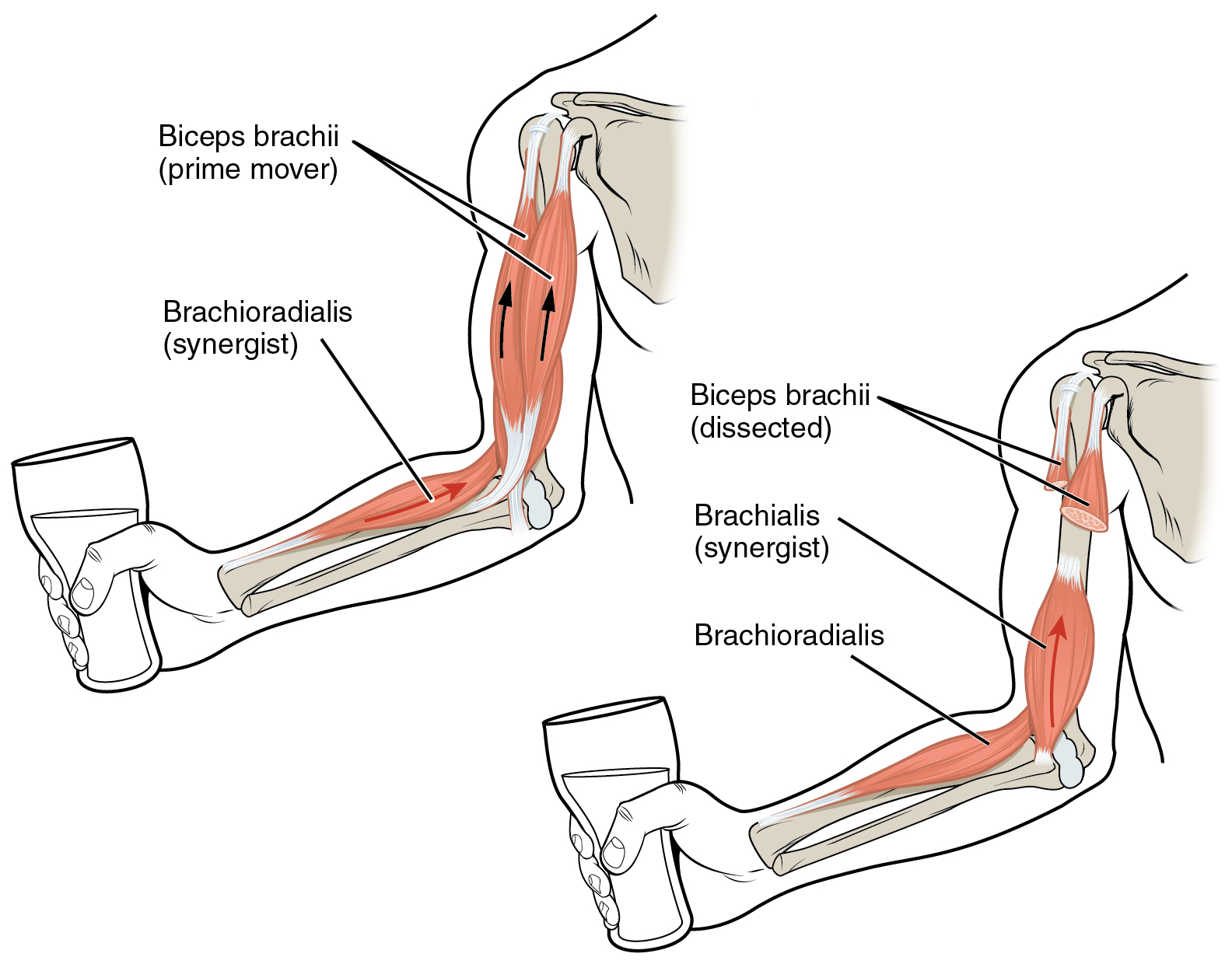
By the end of this section, you will be able to identify the following:
Compare and contrast agonist and antagonist muscles
Interactions of Skeletal Muscles in the BodyThe moveable end of the muscle that attaches to the bone being pulled is called the muscle’s insertion, and the end of the muscle attached to a fixed (stabilized) bone is called the origin. Muscle pull rather than push. Upon activation, the muscle pulls the insertion toward the origin.
Although a number of muscles may be involved in an action, the principal muscle involved is called the prime mover, or agonist. During forearm flexion, for example lifting a cup, a muscle called the biceps brachii is the prime mover. Because it can be assisted by the brachialis, the brachialis is called a synergist in this action (Figure 11.1.1). A synergist can also be a fixator that stabilizes the muscle’s origin.

A muscle with the opposite action of the prime mover is called an antagonist. Antagonists play two important roles in muscle function: (1) they maintain body or limb position, such as holding the arm out or standing erect; and (2) they control rapid movement, as in shadow boxing without landing a punch or the ability to check the motion of a limb.
For example, to extend the leg at the knee, a group of four muscles called the quadriceps femoris in the anterior compartment of the thigh are activated (and would be called the agonists of leg extension at the knee). A set of antagonists called the hamstrings in the posterior compartment of the thigh are activated to slow or stop the movement.
These terms are reversed for the opposite action, flexion of the leg at the knee. In this case the hamstrings would be called the agonists and the quadriceps femoris would be called the antagonists.
There are also muscles that do not pull against the skeleton for movements such as the muscles of facial expressions. The insertions and origins of facial muscles are in the skin, so that certain individual muscles contract to form a smile or frown, form sounds or words, and raise the eyebrows. There also are skeletal muscles in the tongue, and the external urinary and anal sphincters that allow for voluntary regulation of urination and defecation, respectively. There are four helpful rules that can be applied to all major joints except the ankle and knee because the lower extremity is rotated during development. For example, in the case of the knee, muscles of the posterior thigh cause knee flexion and anterior thigh muscles cause knee extension, which is opposite of the rules stated below for most other joints.
Skeletal muscles each have an origin and an insertion. The end of the muscle that attaches to the bone being pulled is called the muscle’s insertion and the end of the muscle attached to a fixed, or stabilized, bone is called the origin. The muscle primarily responsible for a movement is called the prime mover, and muscles that assist in this action are called synergists. A synergist that makes the insertion site more stable is called a fixator. Meanwhile, a muscle with the opposite action of the prime mover is called an antagonist.
abduction the body part moves away from the midline of the body adduction the body part moves toward the midline of the body agonist (also, prime mover) muscle whose contraction is responsible for producing a particular motion antagonist muscle that opposes the action of an agonist extension an increase in joint angle with movement fixator synergist that assists an agonist by preventing or reducing movement at another joint, thereby stabilizing the origin of the agonist flexion a decrease in joint angle with movement insertion end of a skeletal muscle that is attached to the structure (usually a bone) that is moved when the muscle contracts origin end of a skeletal muscle that is attached to another structure (usually a bone) in a fixed position prime mover (also, agonist) principle muscle involved in an action synergist muscle whose contraction helps a prime mover in an action
This work, Anatomy & Physiology, is adapted from Anatomy & Physiology by OpenStax, licensed under CC BY. This edition, with revised content and artwork, is licensed under CC BY-SA except where otherwise noted.
Images, from Anatomy & Physiology by OpenStax, are licensed under CC BY except where otherwise noted.
Anatomy & Physiology Copyright © 2019 by Lindsay M. Biga, Staci Bronson, Sierra Dawson, Amy Harwell, Robin Hopkins, Joel Kaufmann, Mike LeMaster, Philip Matern, Katie Morrison-Graham, Kristen Oja, Devon Quick, Jon Runyeon, OSU OERU, and OpenStax is licensed under a Creative Commons Attribution-ShareAlike 4.0 International License, except where otherwise noted.